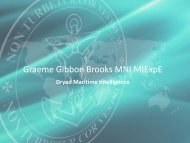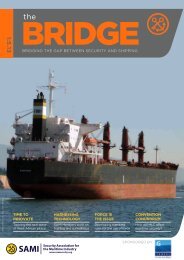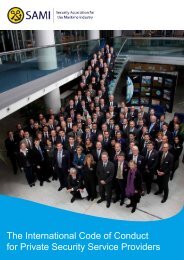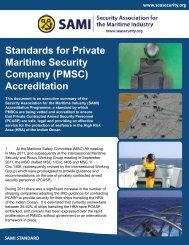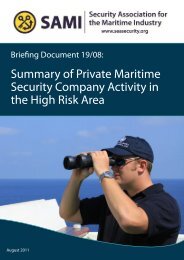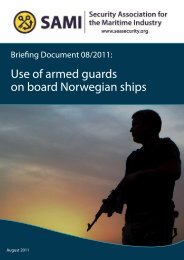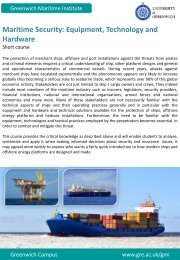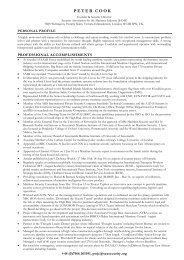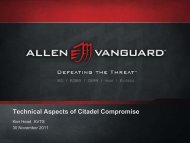SAMI Briefing Maritime Labour Convention FAQs and Text March 2013
SAMI Briefing Maritime Labour Convention FAQs and Text March 2013
SAMI Briefing Maritime Labour Convention FAQs and Text March 2013
You also want an ePaper? Increase the reach of your titles
YUMPU automatically turns print PDFs into web optimized ePapers that Google loves.
<strong>Maritime</strong> <strong>Labour</strong> <strong>Convention</strong>, 2006to occur on board a ship <strong>and</strong> to make use of medical advice by radio or satellitecommunication; <strong>and</strong>(b) all other ships should have at least one designated seafarer with approved trainingin medical care required by STCW, including practical training <strong>and</strong> trainingin life-saving techniques such as intravenous therapy, which will enable the personsconcerned to participate effectively in coordinated schemes for medical assistanceto ships at sea, <strong>and</strong> to provide the sick or injured with a satisfactoryst<strong>and</strong>ard of medical care during the period they are likely to remain on board.2. The training referred to in paragraph 1 of this Guideline should be based onthe contents of the most recent editions of the International Medical Guide for Ships,the Medical First Aid Guide for Use in Accidents Involving Dangerous Goods, theDocument for Guidance – An International <strong>Maritime</strong> Training Guide, <strong>and</strong> the medicalsection of the International Code of Signals as well as similar national guides.3. Persons referred to in paragraph 1 of this Guideline <strong>and</strong> such other seafarersas may be required by the competent authority should undergo, at approximately fiveyearintervals, refresher courses to enable them to maintain <strong>and</strong> increase their knowledge<strong>and</strong> skills <strong>and</strong> to keep up-to-date with new developments.4. The medicine chest <strong>and</strong> its contents, as well as the medical equipment <strong>and</strong>medical guide carried on board, should be properly maintained <strong>and</strong> inspected at regularintervals, not exceeding 12 months, by responsible persons designated by the competentauthority, who should ensure that the labelling, expiry dates <strong>and</strong> conditions ofstorage of all medicines <strong>and</strong> directions for their use are checked <strong>and</strong> all equipmentfunctioning as required. In adopting or reviewing the ship’s medical guide used nationally,<strong>and</strong> in determining the contents of the medicine chest <strong>and</strong> medical equipment, thecompetent authority should take into account international recommendations in thisfield, including the latest edition of the International Medical Guide for Ships, <strong>and</strong>other guides mentioned in paragraph 2 of this Guideline.5. Where a cargo which is classified dangerous has not been included in the mostrecent edition of the Medical First Aid Guide for Use in Accidents Involving DangerousGoods, the necessary information on the nature of the substances, the risks involved, thenecessary personal protective devices, the relevant medical procedures <strong>and</strong> specific antidotesshould be made available to the seafarers. Such specific antidotes <strong>and</strong> personalprotective devices should be on board whenever dangerous goods are carried. This informationshould be integrated with the ship’s policies <strong>and</strong> programmes on occupationalsafety <strong>and</strong> health described in Regulation 4.3 <strong>and</strong> related Code provisions.6. All ships should carry a complete <strong>and</strong> up-to-date list of radio stations throughwhich medical advice can be obtained; <strong>and</strong>, if equipped with a system of satellite communication,carry an up-to-date <strong>and</strong> complete list of coast earth stations through whichmedical advice can be obtained. Seafarers with responsibility for medical care ormedical first aid on board should be instructed in the use of the ship’s medical guide<strong>and</strong> the medical section of the most recent edition of the International Code of Signalsso as to enable them to underst<strong>and</strong> the type of information needed by the advising doctoras well as the advice received.Guideline B4.1.2 – Medical report form1. The st<strong>and</strong>ard medical report form for seafarers required under Part A of thisCode should be designed to facilitate the exchange of medical <strong>and</strong> related informationconcerning individual seafarers between ship <strong>and</strong> shore in cases of illness or injury.56




